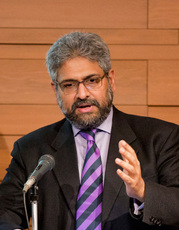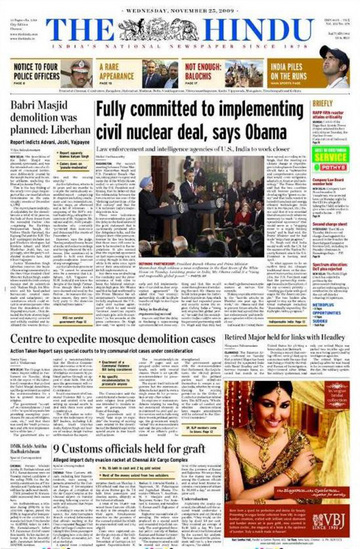India's Foreign and Strategic Policy in Asia The India-China-U.S. Troika and Japan
Siddharth Varadarajan
Editor, The Hindu
As the world enters the era of what political scientist Ian Bremmer calls a G-Zero world, where power is diffused at the global level and there is no single superpower, Asia is a major center of gravity. Mr. Siddharth Varadarajan, editor of The Hindu, an influential and respected English- language newspaper, talks about India's diplomatic policy in Asia and Japan's future role in relation to U.S.-China relations.
An era of diffused polarity
Nowadays, we are dealing with a situation of diffused polarity, if one were to characterize it using one of those glib phrases. I think that's quite an accurate description of the kind of global system we have. Unlike the unipolar or bipolar system, the problem with diffused polarity is that it precludes the possibility of any stable equilibrium emerging either at the global or the regional level. During the unipolar system which supposedly existed for a brief period, or the bipolar system that existed of course for a much longer period, there was instability in those systems too. But the instability of the bipolar world was what an engineer would call predictive instability -- something that you roughly knew the broad contours of even if you were always surprised when it presented itself in a specific way. Today we have an instability that is really quite unpredictable, and this is what renders it especially difficult for policy makers and for countries that are trying to chart a strategic course through these very choppy waters.
India-U.S. relations
The India-U.S. relationship has recovered considerably in this past decade. During the second term of the George W. Bush administration, the United States made a decision to try and influence, or even limit, the kind of strategic choices that India could make at a given moment in time. The United States was conscious of the need to have India as a partner to hedge against China's rise. And the nuclear deal it offered in July 2005 was leveraged as a means to, in a way, accomplish this. There were other calculations on the U.S. side too but it is not accidental that India-China relations, which had recovered from the dip which happened after the 1998 nuclear tests, suffered as a consequence of the new India-U.S. relationship.
In the U.S. Congress, and among U.S. strategic analysts, this was a constant theme -- that we are befriending India, we are building a partnership with India, as a hedge against China. But such a framing was not healthy for India. After all, if the American reaching out to India is a function of its relationship with China and is contingent in some way on Washington's desire to hedge against Beijing, what happens if tomorrow the United States decides for reasons of its own that it now needs to strengthen its relationship with China? The India relationship would be a casualty. And we actually saw this happen in the first year of the Obama administration.
When the 2008 world financial crisis hit with full force, the Chinese had a very important role to play in helping the world. There was a lot of anxiety on the U.S. side that we shouldn't alienate China, we should find a working relationship. There was even some heady talk of"G2,"of a world led by the United States and China. Fortunately, for India and for Japan, the Chinese were not interested in a G2 because they knew that in any G2, the United States would expect China to be number two, and the Chinese don't believe in being number two. So the G2 concept never really took off, and U.S.-China relations veered off anyway, for a variety of reasons, and so you had, from 2010 onwards, a fresh attempt by India and the United States to revive their relationship. From an Indian point of view, however, the lesson here is that building your relationship with one country because that country wants to hedge against another is perhaps never a wise strategy.
India-China relations
As mentioned, the India-China relationship improved dramatically until about 2005, when it reached a certain plateau. Today, thanks to fresh efforts on both sides, the relationship is back on track, trade is booming, and China today is India's largest trading partner. The boundary issue remains unresolved, and there have been moments of awkwardness due to intrusions, but by mutual understanding the countries have more or less agreed to set it aside for future resolution.
However, beside these problems, there exist bilateral irritants that remain. For example, the Chinese objections to the nuclear deal with India, which persisted at the last NSG (Nuclear Suppliers Groups) meeting in Vienna. The Chinese, according to some accounts, strongly opposed making India a member of the NSG, which virtually every other energy member backed. Another strategic irritant is the Chinese relationship with Pakistan. You have short-term irritants as well, which are perhaps more tactical in nature and are largely driven by what I think are Chinese insecurities and fears about the situation in Tibet. But there are strategic irritants that India really cannot take lightly.
Nevertheless, if you were to plot a graph of the India-China relationship, the trajectory is unmistakably upward. No question about it. Under any metric, whether it's trade, investment, high-level political visits, tourist arrivals, or even military-to-military discussions and exchanges, the improvement is obvious. So the trend is unmistakably upward. Of course, in the short term, you may have perturbations so if you were to take a very narrow view in such a period, it may seem as if relations are on a downward slope, but the long view is very clearly upward. That's not to say India does not share many of the concerns of the United States or Japan regarding the future uncertainties of Chinese policy, but broadly speaking, the relationship is one that the Indian side and the Chinese side appear to be working quite carefully on.
U.S.-China relations
What about U.S.-China relations? I think in the past decades, we've seen so many different approaches--beginning with the Clinton era where you have "blow hot, blow cold"--but ultimately you have a lot of tough talk which flounders on the reality of the amount of American investment in China, the size of the Chinese trade surplus, and the size of Chinese holdings of American T-bills. The fact of the matter is that containment, even if American politicians were to fantasize about it, is not possible in today's world. Containment worked, arguably, during the Cold War because the former Soviet Union and the former Comecon inhabited a parallel universe that really had very little connection with the rest of the world. But how can you contain, or tether, or restrain in some way an economy the size of China's? Given the level of Chinese integration in the global, economic, and financial system, the idea of trying to contain this country is really quite laughable, which is why the sensible American policy circles are also avoiding this kind of mindset, this kind of terminology.
U.S. policy makers have approached the impossibility of containing China with different theses. In the George W. Bush era, apart from the desire to hedge against China, you had the concept of trying to push China to be a responsible stakeholder in the international system. Of course the Chinese response to all of these attempts by the United States to tether them was to pursue strategic ambivalence. Therefore, we could say that the relation between the United States and China is very complex.
And of course now, from November 2011 onwards, you have the Obama administration's declaration that it is back in Asia and that it will work to rebalance the continent. This is the so-called Asia pivot. Although, again, I feel that the Asia pivot has a strategic and a tactical component. The strategic component is very clear because in the long term any serious analyst will have to agree that the United States and China will remain rivals, and that this rivalry will only grow over time in economic and strategic terms. But this does not rule out the possibility of tactical adjustments. For example, as the threats being used by North Korea escalate and begin to sound more alarming, it is quite possible that the United States would actually encourage the Chinese side to try to ensure that the situation does not get out of control.
So we should not forget that the American pivot to Asia also allows a lot of flexibility for the pursuit of tactical microstrategies.
India-Japan relations
What does this tell us about India and Japan? The Japan factor is absolutely crucial here because, despite my dire predictions about its declining share in world output, it is and will remain a major player. The bilateral trade between Japan and India is about 18-19 billion dollars a year, and the plan is to push it to 25 billion dollars by next year. But this is of course much less than India-China trade, which is over 100 billion dollars. But nevertheless, if we hit that target next year, it is something that is really quite significant. Japan in the past decade, at roughly 12-14 billion dollars, is the fourth largest investor in India. The Japanese have made very strong commitments toward Indian infrastructure. I think alone among India's international partners, the Japanese have very wisely chosen to focus on those areas that are actually holding back India's economic development and hence the deeper integration of India into the wider Asian region. You have a number of Japanese companies and Japanese brands that are visible, which have created a lot of goodwill and have helped to solidify in the mind of the average Indian that Japan is still a very, very important partner for India.
On the other hand, the fact remains that Japan is a military ally of the United States and in some ways under the current dispensation is looking to deepen that alliance even further. This fact has positive and negative consequences for India. On the positive side, this means that there are a number of initiatives that we can take together. Interoperability can be pursued, there's a certain comfort level in doing joint exercises or thinking of joint projects at the level or training, and so on. On the negative side, India has to be mindful of the kind of signals that close military-to-military cooperation with an American military ally might send across the wider region and to China.
At the same time, Japan's difficult relations with China have both, again, positive and negative consequences for India. I'm not sure if Thomas Friedman's pseudo-theory that two countries that trade with each other or invest in each other may never go to war applies here or not. Certainly, there's no question of war, but if you look at the tension that prevails at various points of time between China and Japan, or China and many of its other important trading partners, it's clear that the level of economic interaction is no guarantee for a stable political relationship. To the extent to which the Japanese feel pressure from the Chinese side, this acts as an inducement for the Japanese to reach out to like-minded countries, India being one of them. And I have no doubt in my mind that a lot of the long-term investment, political investment, and even economic investment that Japan is making in India is in part fueled by a latent insecurity about U.S. long-term intentions in Asia and the consequences of a possible less-than-peaceful rise of China. So Japan in its own way is reaching out, building partnerships, and hedging its bets. But if it were to be widely publicized that the main reason why Japan wants to have relations with India is to make common cause against China, all of this would have very negative consequences. Indeed, there's a great deal of aversion in Indian policy circles to this kind of talk.
The India-U.S.-China troika
When we speak of a troika--India, the United States, and China--who will be the center of this troika is really important. Today, it is the United States that is doing the balancing because, notwithstanding any long-term rivalries, U.S.-China communication, trade, and interaction is at a much greater level than India-U.S. communication and trade or India-China interaction --even though at a cultural or political level, there is a greater comfort between India and the United States. The United States and China will continue to have an ambiguous relationship in which rivalry will alternate or even coexist with tactical understandings at the global and national level. So we may need a more complicated three-dimensional kind of diagram to capture the complexity of this kind of balancing act.
For India, it is really important to strive to be at the center of the troika. And Japan is in the same position as India in any Japan-China-U.S. troika. It's maybe a bit of a fantasy or wishful thinking, but Japan really should also be a country that can provide a sort of balance in the wider situation.
It's important for both Japan and India to not treat their relations in Asia as a zero-sum game. India should not look at its relations with China as a derivative of U.S.-China relations, nor should we look at our relations with Japan as a derivative of Japan-China relations. The more we do that, the greater is the danger that we will run into trouble, that the India-China relationship will be hostage to any improvements that may happen on the U.S.-China front or the Japan-China front.
The U.S.-China graph, if you were to take a long view, would no doubt show a downward trend, perhaps gently, not very dramatically. But within that gentle downward trend, there will be moments of upswing and downswing. It's very important for both Japan and India to recognize that and not be wrong-footed by these moments of upswing. It is essential that both India and Japan factor in this very, very complex and ambiguous relationship that the United States and China will continue to have.
The United States is definitely looking to diffuse Chinese power through both qualitative and quantitative initiatives and groupings. A qualitative initiative would be the Asia pivot where you come up with a strategy and try to build a rationale for your reengagement and possible assertion of leadership in the Asian region. A quantitative initiative or grouping would be something like the TPP, the Trans-Pacific Partnership, which, to my mind, may have a certain narrow economic logic from the point of view of the United States or some of the Asian or Pacific countries, but which again seeks to dilute Chinese power. These kinds of initiatives are likely to deepen divisions and suspicions in Asia rather than to bridge them or create an atmosphere for more cooperative relations.
The future agenda for India and Japan
What would a future agenda for India and Japan look like? First of all, it is obvious that deepening the bilateral relationship, especially at the level of political understanding, is essential. The economic relationship is more or less on track. But there are some unnecessary irritants at the political level, especially on the issue of nuclear energy cooperation.
Secondly, we both have to learn to live with the reality that in the long run there will be a slow buildup of U.S.-China rivalry. It's not just the rise of China that is the source of instability and uncertainty in Asia and the world―it's the response of the United States to the rise of China and the dynamic between these two countries that is likely to be the source of much instability and tension in the year ahead.
If you take a broader view, rather than encouraging or looking for ways to push this rivalry further and to take advantage of it, we need to work together to create the kind of architecture that can mitigate and contain this rivalry. This, in my opinion, is the containment that Asia badly needs, and it is as good a pivot as any to try to reimagine the India-Japan relationship.
This is an edited transcript of a lecture at I-House on March 28, 2013.
 Siddharth Varadarajan
Siddharth Varadarajan
Editor, The Hindu. He covers a broad range of international issues, such as the relationship between India and China in Asia and India's foreign policy. Prior to joining The Hindu, he worked at The Times of India for nine years. In May 2011, he was appointed editor in chief, as the first non-family, professional editor.
Varadarajan has also been involved with the academic world in the course of his work. After studying at the London School of Economics and Columbia University, he taught at New York University as a trained economist until 1995. He was also a visiting professor at the University of California, Berkeley, in 2007 and a Poynter Media Fellow at Yale University in 2009.
He has edited Gujarat: The Making of a Tragedy (Penguin Global, 2002).
Back Issues
- 2019.8. 6 Unraveling the Maker…
- 2018.8.30 Japanese Photography…
- 2017.6.19 Speaking of Soseki 1…
- 2017.4.12 Singing the Twilight…
- 2016.11. 1 Poetry? In Postwar J…
- 2016.7.29 The New Generation o…
- 2016.4.14 Pondering "Revitaliz…
- 2016.1.25 The Style of East As…
- 2015.9.30 Anime as (Particular…
- 2015.9. 1 The Return of a Chin…






